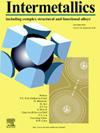Corrosion mechanism of CrMnFeCoNi high entropy alloy in nitric acid solution
IF 4.3
2区 材料科学
Q2 CHEMISTRY, PHYSICAL
引用次数: 0
Abstract
The corrosion behavior and passive film characteristics of CrMnFeCoNi high entropy alloy (HEA) in HNO3 solution (0.1 M, 1 M, 4 M and 6 M) was investigated. The electrochemical test results demonstrated enhanced corrosion resistance with increasing HNO3 concentration, evidenced by higher corrosion potential, lower passivation current density, and larger impedance modulus value. XPS and finite element analysis confirmed that the improved corrosion resistance in 6 M HNO3 was attributed to a Cr2O3-rich passive film (22.5 %), formed via autocatalytic redox reactions and stabilized by Mn2+ inhibiting Cr(III) oxidation.
crmnnfeconi高熵合金在硝酸溶液中的腐蚀机理
研究了CrMnFeCoNi高熵合金(HEA)在HNO3溶液(0.1 M、1 M、4 M和6 M)中的腐蚀行为和钝化膜特性。电化学测试结果表明,随着HNO3浓度的增加,材料的耐蚀性增强,表现为腐蚀电位升高、钝化电流密度降低、阻抗模量增大。XPS和有限元分析证实,6 M HNO3中耐蚀性能的提高是由于一层富含cr2o3(22.5%)的钝化膜,通过自催化氧化还原反应形成,并通过Mn2+抑制Cr(III)氧化而稳定。
本文章由计算机程序翻译,如有差异,请以英文原文为准。
求助全文
约1分钟内获得全文
求助全文
来源期刊

Intermetallics
工程技术-材料科学:综合
CiteScore
7.80
自引率
9.10%
发文量
291
审稿时长
37 days
期刊介绍:
This journal is a platform for publishing innovative research and overviews for advancing our understanding of the structure, property, and functionality of complex metallic alloys, including intermetallics, metallic glasses, and high entropy alloys.
The journal reports the science and engineering of metallic materials in the following aspects:
Theories and experiments which address the relationship between property and structure in all length scales.
Physical modeling and numerical simulations which provide a comprehensive understanding of experimental observations.
Stimulated methodologies to characterize the structure and chemistry of materials that correlate the properties.
Technological applications resulting from the understanding of property-structure relationship in materials.
Novel and cutting-edge results warranting rapid communication.
The journal also publishes special issues on selected topics and overviews by invitation only.
 求助内容:
求助内容: 应助结果提醒方式:
应助结果提醒方式:


